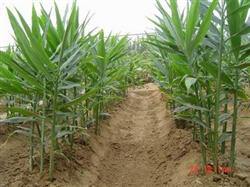Post-autumn management technology of ginger

After the Beginning of Autumn, the weather was cool and entered a period of rapid expansion of ginger, in which there was more demand for water and fertilizer and more occurrence of diseases and insect pests, which was also a key period for prevention and control, so it was very important to strengthen the management of ginger in the middle and later stage. Next, the relevant technical points are introduced as follows. 1. Watering: ginger likes to be moist but not resistant to drought, so it is generally appropriate to water after shallow hoeing and loosening the soil. In case of drought, watering times should be increased, but do not flood irrigation. September is the best time for ginger rhizome growth, and the demand for water is obviously on the high side. Watering every 7 to 10 days is appropriate, and Rain Water should be watered less when there is too much water. Watering time should be in the morning and evening, and try not to water at noon. two。 Topdressing: ginger has a long growing period and needs a large amount of fertilizer, especially in the middle and later stages of ginger, which accounts for about 80% of the whole growth period. After the Beginning of Autumn, combined with pulling out weeds or dismantling ginger shed for topdressing, it requires adequate fertilizer, comprehensive nutrition and long-lasting fertilizer effect. A fertilizer application ditch was opened on the north side of the ginger seedling 15-20 cm from the base of the plant, with a depth of 10 cm. 70-80 kg of rotten bean cake or 500 kg of rotten dung was applied per mu, plus 30 kg of ternary compound fertilizer of nitrogen, phosphorus and potassium. The fertilizer was spread evenly in the fertilizer ditch to cover the soil, and then watered thoroughly. In the first and middle of September, when the ginger seedlings had 6-8 bifurcations, the rhizome expanded rapidly, and topdressing could be carried out according to the plant growth. The general application of 4kg nitrogen fertilizer per mu, combined with topdressing to supplement boron fertilizer, zinc fertilizer and other micro-fertilizers in time, zinc sulfate 2kg and borax 1kg per mu play a very important role in improving the yield and quality of ginger.
- Prev

A simple method of Ginger cultivation with plastic Film mulching
The softening cultivation of ginger is a measure to increase the cultivation density and strengthen the shading and cooling on the basis of the normal cultivation of ginger, so as to achieve the purpose of harvesting tender ginger. The tender ginger harvested in this way has not only a long harvest time and high yield, but also fresh and crisp, thin skin and sparse skin, with a delicate ginger flavor when eaten. First, land selection and seed selection. Choose three in a row.
- Next

High-yield cultivation techniques of Ginger and Taro
Ginger and taro are the traditional characteristic agricultural products in our city. In recent years, with the adjustment of crop planting structure and the pull of market price, the planting area of ginger and taro in our city is also expanding, which has become one of the main characteristic agricultural products in our city. At present, our city ginger, taro has been sown, is in.
Related
- Where is it suitable to grow horseradish in China? it is expected to see the middle altitude horseradish in Alishan.
- How to prevent tomato virus disease reasonably? (Control methods included)
- Many people like to plant towel gourd on the balcony. What are the main points of this method and management?
- What crops can chili peppers be mixed with?
- Fertilization techniques and matters needing attention in Tomato
- What are the grafting techniques for peach seedlings in spring?
- Harm and control methods of root swelling disease of Chinese cabbage
- What are the pests of sweet potatoes? How to prevent and cure it?
- Symptoms, causes and Control methods of navel Rot in Tomato
- The cause of "Cucumber rotten bibcock" in Farmers' planting Cucumber and its Control Plan

